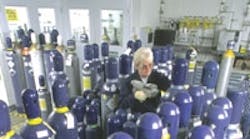When John Jones was promoted to chairman of Air Products and Chemicals Inc. back in 2000, he set out to transform the company to higher levels of growth and profitability. It wasn't that the Allentown, Pa.-based chemical and gases company was in trouble, but "we were pretty much entrepreneurial to a fault," remembers George Diehl, Air Products' global director of process management. "We had a lot [of] 'my department, my region, my business' thinking going on."
Jones' vision, part of an overall strategy known as Deliver the Difference, is centered on a corporatewide adoption of common processes. Taking to heart the theory that "you can't manage what you can't measure," Air Products found that it could be more efficient and effective if, instead of trying to support seven or eight IT systems, it focused on one common supply chain platform (namely, SAP), with common metrics. "Our transformation was built around a common organization, a common set of metrics, a common process, a common supply chain, a common implementation of SAP, across all the countries where we operate," Diehl explains.
Using the Supply Chain Council's guidelines on defining core supply chain processes (plan, source, make, deliver and return), Air Products now measures five key areas of its supply chain: cash-to-cash cycle time, perfect order fulfillment, demand forecast accuracy, resolution of customer complaints and customer master data accuracy.
The best way to measure supply chain performance, according to AMR Research, "is to match technology to your specific organizational requirements," and in addition to running its supply chain processes through the mySAP Business Suite, Air Products also uses Steelwedge as its sales and operational planning (S&OP) solution.
For instance, after benchmarking its cash-to-cash cycle time both within and outside the chemical industry, Air Products determined that its cycle time was too high. By studying the three components of cash-to-cash cycle time -- how fast you pay your suppliers, how much inventory you carry, and how much your receivables are worth -- the company determined that its sales staff wasn't adhering to the standard terms for receivables. "As a result," Diehl says, "our customers were taking much longer to pay us." The next step was to make the sales people aware of the problem and then insist that they sign all future contracts with a specific target date for receivables. "As a result, we shaved about 10 days off our cash-to-cash cycle," he observes.
Through a similar study of its supply chain processes, high-tech giant Hewlett-Packard Co. was able to reduce its manufacturing cycle time from about 18 days to two days over a two-year period. The key there, relates Jack Faber, supply chain vice president of HP's Enterprise Storage and Servers division, was developing a time-stamp system that allowed the company to identify where queues were being created during the manufacturing process. "You can improve a process simply by defining it in its most narrow terms," Faber notes, "and then applying continuous improvement techniques."
For HP, being able to measure its supply chain performance has become essential in this era of environmental compliance issues. "It used to be only once in a while that a customer would ask us, say, how many kilowatts it takes us to produce a product; now, it's 15% to 20% of orders, especially government tenders, that want to know that kind of information. They want to know about the working conditions at our suppliers, and being able to measure that performance and then being able to respond on a regular basis has become a key competitive advantage for us."



